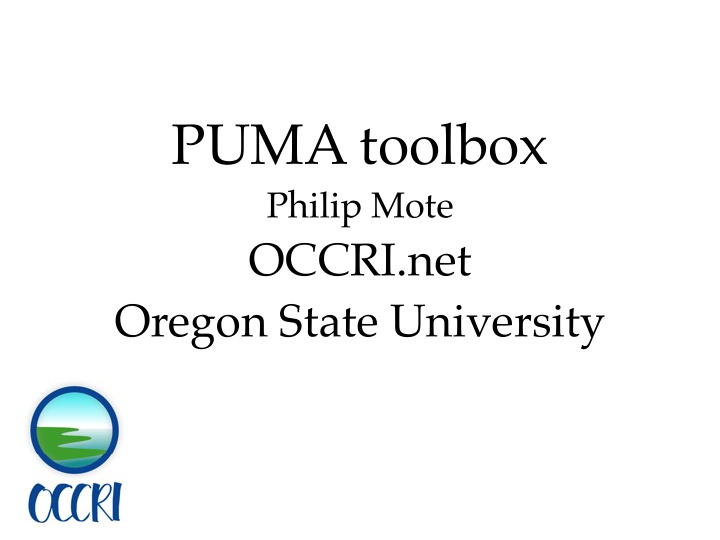



PUMA toolbox Philip Mote OCCRI.net Oregon State University Philip Mote
CMIP3 CMIP5 NARCCAP regCPDN WRF observations delta BCSD CA BCCA MACA etc. reanalysis PRISM
nationality model BCCR CCSM3 CGCM (T47) CGCM (T63) CNRM CSIRO ECHAM5 ECHO-G FGOALS GFDL-CM2.0 GFDL-CM2.1 GISS-AOM GISS-ER HADCM3 HADGEM1 INMCM IPSL MIROC MIROC-hires PCM
!
PNW changes Mote and Salathé 2010 - graphics by Jeremy Littell
“Worst” Climate variable “Best” Mean Median Model used in IPCC Fourth Assessment Gleckler, Taylor, and Doutriaux, Journal of Geophysical Research (2008)
20th century seasonal cycle Mean precipitation 25 gfdl_cm2_1 giss_aom giss_er 20 hadcm hadgem1 inmcm3_0 ipsl_cm4 miroc3_2_hi miroc_3.2 15 pcm1 multi-model avg cm NCEP 10 5 0 Jan Mar May Jul Sep Nov Jan Mote and Salathé 2010
2080s PNW summer precipitation change 40 20 0 % change -20 -40 -60 0.0 0.2 0.4 0.6 0.8 1.0 Skill factor Mote, Brekke, Du fg y, Maurer 2011 10
NARCCAP narccap.ucar.edu
NARCCAP
climateprediction.net (CPDN)
Simulated July Tmax Observed (PRISM) July Tmax
Multivariate Adaptive Constructed Analogs (MACA) Meeting the needs of fire management Late 20 th Mid 21 st 20C3M Needs 1. Full meteorology: TMAX/TMIN, ppt, winds, RH, solar 2. Daily timescales Methods 1. Combines attributes of CA and BCSD methods similar to BCCA (Maurer and Hidalgo, 2010) 2. Accounts for disappearing analogs, new variables 3. Compared to daily BCSD method TEMP, RH, PPT, 10-m winds Abatzoglou and Brown, submitted 8km resolution
MAC advice Considerations in design of climate scenarios Which variables and at what time/space res. how to characterize uncertainty model evaluation? Other considerations: paleo, time-to-detection,
MAC advice Dynamical vs statistical always some statistical (remove biases, get large ensemble); dynamical for physical relationships, extremes; evaluate approaches according to needs at hand
Recommend
More recommend